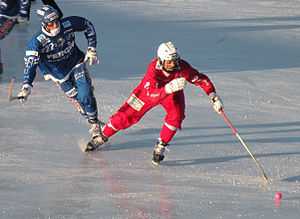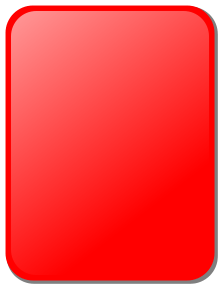Bandy
|
Bandy players in January 2011 | |
| Highest governing body | Federation of International Bandy |
|---|---|
| Nicknames | winter football[1] |
| First played | 1875, London, England |
| Characteristics | |
| Contact | Limited |
| Team members | 11 field players |
| Type | team sport, winter sport |
| Equipment | Bandy ball, bandy stick, skates, protective gear |
| Venue | ice field, bandy arena |
| Presence | |
| Olympic | demonstration 1952 |
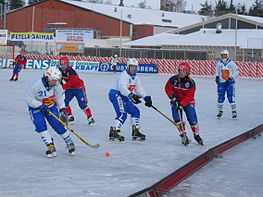
Bandy is a team winter sport played on ice, in which skaters use sticks to direct a ball into the opposing team's goal.[2]
The sport has common background with association football, ice hockey and field hockey. Like football, the game is normally played in halves of 45 minutes each, there are eleven players on each team, and the bandy field is about the same size as a football pitch. It is played on ice like ice hockey, but like field hockey, players use bowed sticks and a small ball.
If it is very cold or if it is snowing, the match can be broken into thirds of 30 minutes each. In the World Championships the two halves can be 30 minutes each for the "smaller" nations.
A variant of bandy, rink bandy, is played to the same rules but on a field the size of an ice hockey rink and with fewer people on each team. Bandy is also the predecessor of floorball, which was invented when people started playing with plastic bandy-shaped sticks and light balls when running on the floors of indoors gym halls.
Games
Bandy is played on ice, using a single round ball. Two teams of 11 players each compete to get the ball into the other team's goal using sticks, thereby scoring a goal.[3]
The game is designed to be played on a rectangle of ice that is the same size as a soccer field. Bandy also has other rules that are similar to soccer. Each team has 11 players, one of whom is a goalkeeper. The offside rule is also employed.[4] A goal cannot be scored from a stroke-in or goal throw, but unlike soccer, a goal cannot be scored directly from a stroke-off or corner stroke.[5] All free strokes are “direct” and allow a goal to be scored without another player touching the ball.
The team that has scored more goals at the end of the game is the winner. If both teams have scored an equal number of goals, then, with some exceptions, the game is a draw.
The primary rule is that the players (other than the goalkeepers) may not intentionally touch the ball with their heads, hands or arms during play. Although players usually use their sticks to move the ball around, they may use any part of their bodies other than their heads, hands or arms and may use their skates in a limited manner. Heading the ball will result in a five-minute penalty.
In typical game play, players attempt to propel the ball toward their opponents' goal through individual control of the ball, such as by dribbling, passing the ball to a team-mate, and by taking shots at the goal, which is guarded by the opposing goalkeeper. Opposing players may try to regain control of the ball by intercepting a pass or through tackling the opponent who controls the ball. However, physical contact between opponents is limited. Bandy is generally a free-flowing game, with play stopping only when the ball has left the field of play, or when play is stopped by the referee. After a stoppage, play can recommence with a free stroke, a penalty shot or a corner stroke. If the ball has left the field along the sidelines, the referee must decide which team touched the ball last, and award a restart stroke to the opposing team, just like football's throw-in.
The rules do not specify any player positions other than goalkeeper, but a number of player specialisations have evolved. Broadly, these include three main categories: forwards, whose main task is to score goals; defenders, who specialise in preventing their opponents from scoring; and midfielders, who dispossess the opposition and keep possession of the ball to pass it to the forwards. Players in these positions are referred to as outfield players, to discern them from the single goalkeeper. These positions are further differentiated by which side of the field the player spends most time in. For example, there are central defenders, and left and right midfielders. The ten outfield players may be arranged in these positions in any combination (for example, there may be three defenders, five midfielders, and two forwards), and the number of players in each position determines the style of the team's play; more forwards and fewer defenders would create a more aggressive and offensive-minded game, while the reverse would create a slower, more defensive style of play. While players may spend most of the game in a specific position, there are few restrictions on player movement, and players can switch positions at any time. The layout of the players on the pitch is called the team's formation, and defining the team's formation and tactics is usually the prerogative of the team's manager(s).
Rules
Overview
There are eighteen rules in official play. The same rules are designed to apply to all levels of bandy, although certain modifications for groups such as juniors, seniors or women are permitted. The rules are often framed in broad terms, which allow flexibility in their application depending on the nature of the game. The rules can be found on the official website of the Federation of International Bandy.[4]
Players and officials

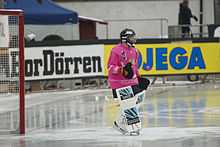
Each team consists of a maximum of 11 players (excluding substitutes), one of whom must be the goalkeeper. A team of fewer than eight players may not start a game. Goalkeepers are the only players allowed to play the ball with their hands or arms, but they are only allowed to do so within the penalty area in front of their own goal. Though there are a variety of positions in which the outfield (non-goalkeeper) players are strategically placed by a coach, these positions are not defined or required by the rules of the game.
Any number of players may be replaced by substitutes during the course of the game. Substitutions can be performed without notifying the referee and can be performed while the ball is in play. However, if the substitute enters the ice before his teammate has left it, this will result in a five-minute ban. A team can bring at the most four substitutes to the game and one of these is likely to be an extra goalkeeper.
A game is officiated by a referee, the authority and enforcer of the rules, whose decisions are final. The referee may be assisted by one or two assistant referees.
Equipment
The basic equipment players are required to wear include a pair of skates, a helmet, a mouth guard and, in the case of the goalkeeper, a face guard. The teams must wear uniforms that make it easy to distinguish the two teams. The skates, sticks and any tape on the stick must be of another colour than the ball.
In addition to the aforementioned equipment, various protections are used to protect knees, elbows, genitals and throat. The pants and gloves may contain padding.
The bandy stick
The stick used in Bandy is a natural part of the sport. The stick should be made of an approved material such as wood or another similar material and it should not contain any metals or sharp parts which can hurt the surrounding players. The bandy stick should be crooked and the bend of the blade is split up into 5 different dimensions, where 1 has the smallest bend and 5 has the most. Bend 4 is the most common size in professional bandy. The bandy stick should not have similar colours to the ball, such as orange or pink; it should be no longer than 127 centimetres (50 in), and the breadth should not exceed 7 centimetres (2.8 in).[6]
Field
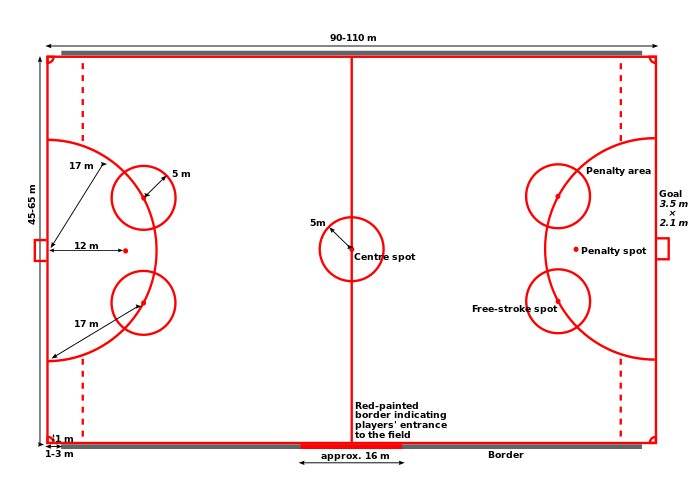
The size of a bandy field is in the range 4,050–7,150 square metres (43,600–77,000 sq ft) (45–65 metres (148–213 ft) by 90–110 metres (300–360 ft)), about the same size as a football pitch and considerably larger than an ice hockey rink. Along the sidelines a 15 cm (6 in) high border (vant, sarg, wand, wall) is placed to prevent the ball from leaving the ice. It should not be attached to the ice, to glide upon collisions, and should end 1–3 metres (3 ft 3 in–9 ft 10 in) away from the corners.
Centered at each shortline is a 3.5 m (11 ft) wide and 2.1 m (6 ft 11 in) high goal cage and in front of the cage is a half-circular penalty area with a 17 m (56 ft) radius. A penalty spot is located 12 metres (39 ft) in front of the goal and there are two free-stroke spots at the penalty area line, each surrounded by a 5 m (16 ft) circle.
A centre spot denotes the center of the field and a circle of radius 5 m (16 ft) is centered at it. A centre-line is drawn through the centre spot and parallel with the shortlines.
At each of the corners, a 1 m (3 ft 3 in) radius quarter-circle is drawn, and a dotted line is painted parallel to the shortline and 5 metres (16 ft) away from it without extending into the penalty area. The dotted line can be replaced with a 0.5-metre (1 ft 8 in) long line starting at the edge of the penalty area and extending towards the sideline, 5 metres (16 ft) from the shortline.
Duration and tie-breaking measures
A standard adult bandy match consists of two periods of 45 minutes each, known as halves. Each half runs continuously, meaning that the clock is not stopped when the ball is out of play; the referee can, however, make allowance for time lost through significant stoppages as described below. There is usually a 15-minute "half-time" break between halves. The end of the match is known as full-time.
The referee is the official timekeeper for the match, and may make an allowance for time lost through substitutions, injured players requiring attention, or other stoppages. This added time is commonly referred to as stoppage time or injury time, and must be reported to the match secretary and the two captains. The referee alone signals the end of the match.
In league competitions games may end in a draw, but in some knockout competitions if a game is tied at the end of regulation time it may go into extra time, which consists of two further 15-minute periods. If the score is still tied after extra time, the game will be replayed. As an alternative, the extra two times 15-minutes may be played as "golden goal" which means that the first team that scores during the extra-time wins the game. If both extra periods are played without a scored goal, a penalty shootout will settle the game. The teams shoot five penalties each and if this doesn't settle the game, the teams shoot one more penalty each until one of them misses and the other scores.
Ball in and out of play
Under the rules, the two basic states of play during a game are ball in play and ball out of play. From the beginning of each playing period with a stroke-off (a set strike from the centre-spot by one team) until the end of the playing period, the ball is in play at all times, except when either the ball leaves the field of play, or play is stopped by the referee. When the ball becomes out of play, play is restarted by one of six restart methods depending on how it went out of play:
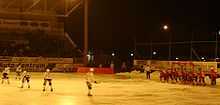
| Method | Description |
|---|---|
| Stroke-off | Following a goal by the opposing team, or to begin each period of play. |
| Goal-throw | When the ball has wholly crossed the goal line without a goal having been scored and having last been touched by a member of the attacking team; awarded to the defending team. |
| Corner stroke | When the ball has wholly crossed the goal line without a goal having been scored and having last been touched by a member of the defending team; awarded to attacking team. The defending team must locate themselves behind goal line and the attacking team must be situated outside the penalty area with everyone but the executor no closer to the shortline than 5 m. As soon as the corner is shot, the attackers may enter the penalty area and the defenders may rush to try to stop the ball. |
| Free-stroke | Awarded to fouled team following certain listed offences, or to the opposing team upon a team causing the ball to leave the field over the side-line. |
| Penalty shot | Awarded to the fouled team following a foul usually punishable by a free-shot but that has occurred within their opponent's penalty area. |
| Face-off | Occurs when the referee has stopped play for any other reason (for example, a serious injury to a player, interference by an external party, or a ball becoming defective). This restart is uncommon in adult games. |
If the time runs out while a team is preparing for a free-stroke or penalty, the strike should still be made but it must go into the goal by one shot to count as a goal. Similarly, a goal made via a corner stroke should be allowed, but it must be executed using only one shot in addition to the strike needed to put the ball in play.
Free-strokes and penalty shots
Free-strokes can be awarded to a team if a player of the opposite team offends any rule, for example, by hitting with the stick against the opponent's stick or skates. Free-strokes can also be awarded upon incorrect execution of corner-strikes, free-strikes, goal-throws, and so on. or the use of incorrect equipment, such as a broken stick.
Rather than stopping play, the referee may allow play to continue when its continuation will benefit the team against which an offence has been committed. This is known as "playing an advantage". The referee may "call back" play and penalise the original offence if the anticipated advantage does not ensue within a short period of time, typically taken to be four to five seconds. Even if an offence is not penalised because the referee plays an advantage, the offender may still be sanctioned (see below) for any associated misconduct at the next stoppage of play.
If a defender violently attacks an opponent within the penalty area, a penalty shot is awarded. Certain other offences, when carried out within the penalty area, result in a penalty shot provided there is a goal situation. These offences include a defender holding or hooking an attacker, or blocking a goal situation with a lifted skate, thrown stick or glove and so on. Also, the defenders (with the exception of the goal-keeper) are not allowed to kneel or lay on the ice. The final offences that might mandate a penalty shot are those of hitting or blocking an opponent's stick or touching the ball with the hands, arms, stick or head above the shoulders. If any of these actions is carried out in a non-goal situation, they shall be awarded with a free-stroke from one of the free-stroke spots at the penalty area line. A penalty shot should always be accompanied by a 5 or 10 minutes penalty (see below). If the penalty results in a goal, the penalty should be considered personal meaning that a substitute can be sent in for the penalised player. This does not apply in the event of a red card (see below).
Warnings and penalties
A ten minutes penalty is indicated through the use of a blue card and can be caused by protesting or behaving incorrectly, attacking an opponent violently or stopping the ball incorrectly to get an advantage.
The third time a player receives a penalty, it will be a personal penalty meaning he or she will miss the remainder of the match. A substitute can enter the field after five or ten minutes. A full game penalty can be received upon using abusive language or directly attacking an opponent and means that the player can neither play nor be substituted for the remainder of the game. A match penalty is indicated through the use of a red card.
Offside
The offside rule effectively limits the ability of attacking players to remain forward (i.e. closer to the opponent's goal-line) of the ball, the second-to-last defending player (which can include the goalkeeper), and the half-way line. This rule is in effect just like that of association football.
| ||||||||||
International
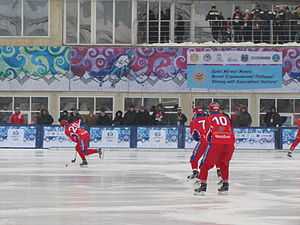
World Championships
The Bandy World Championship for men were first held in 1957 and then every two years starting in 1961, and every year since 2003. Currently the record number of countries participating in the World Championships is 17. The participating countries vary from year to year. Finland won the 2004 world championship in Västerås. All other championships have been won by the Soviet Union, Russia, or Sweden.
In February 2004, Sweden won the first World Championship for women, hosted in Finland, without conceding a goal. The second women's World Championship were held in Roseville, Minnesota at the Guidant John Rose Minnesota Oval in the USA in 2006 and once again Sweden won, defeating Russia in the final (3–1).
Olympic Games
Although bandy was the demonstration sport at the VI Olympic Winter Games in 1952 (Oslo, Norway), and is IOC accepted,[7] it has not become an official Olympic sport. Only three teams played bandy at the 1952 Winter Olympics: Finland, Norway and Sweden.
In 2010 it was reported that FIB president Boris Skrynnik believed bandy would be on the programme for the 2014 Winter Olympics in Sochi,[8] but this did not happen.
Nikolay Valuyev thinks there's a very good chance for inclusion in the 2022 Winter Olympics if Almaty wins the bidding process.[9]
Asian Winter Games
At the 2011 Asian Winter Games, open to members of the Olympic Council of Asia, bandy for men was included for the first time. With Japan as a new FIB member, the international federation is working towards including bandy also in the next games in Sapporo-Obihiro 2017. According to Boris Skrynnik, it is confirmed for inclusion.[10] However, at the official site there is no sign of bandy.[11]
Friendlies
The national teams also meet for friendly games from time to time. Finland, Norway and Sweden usually play Russia in the Russian Government Cup. The USA and Canada meet for friendlies once a year. The central European teams Czech Republic, Germany, Hungary and the Netherlands met for a four nation competition in January 2014, an event which is intended to be recurrent.
World Cup
The World Championships should not be confused with the annual World Cup in Ljusdal, Sweden, which has been played annually since the 1970s and is the biggest bandy tournament for elite level club teams. It was played indoors in Sandviken from 2009 to 2011 because Ljusdal has no indoor arena. It is planned to be in Ljusdal again once an indoor arena has been built. World Cup matches are played day and night, and the tournament is played in four days in late October. The winner in 2008 was Edsbyns IF, the dominant team in Swedish bandy, who had won five straight Swedish championships.[12] As of 2013, the winners have all been Russian teams since 2010.
Since 2007, there is also a Bandy World Cup Women for women's teams.[13]
Champions Cup
Another club tournament is the Champions Cup. It is a pre-season tournament held in Edsbyn, Sweden and features clubs from Russia and Sweden.
International federation
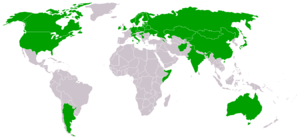
The Federation of International Bandy (FIB) has 32 members (2014).[14] Formed in 1955, the name was changed from International Bandy Federation in 2001 after the International Olympic Committee approved it as a so-called "recognized sport"; the abbreviation "IBF" was already used by another recognized sports federation. In 2004, FIB was fully accepted by IOC.
FIB is now a member of Association of IOC Recognised International Sports Federations.
Winter Universiade
The 2017 Winter Universiade will be held in Almaty with bandy as a demonstration sport.[15][16][17] In Krasnoyarsk 2019 bandy might be one of the sports.[18] If so, it will possibly be played in an indoor arena.[19]
World Championships for students
Two World Championships for students is a requirement before being able to become a full medal sport at the Winter Universiade. Therefore the first tournament will be organised in 2016, in Ulyanovsk.[20]
European Championship
The 1913 European Bandy Championships was held in the Swiss town of Davos with England victorious.[21] It's so far the only tournament. In 2016, it will be held again, also in Davos.
Varieties
Rink bandy is a variety played on an ice hockey-size rink.[22] It was in the programme of the 2012 European Company Sports Games.[23] Some FIB countries don't have a large ice surface and only play rink bandy at home, in fact most of the World Championships Group B participants.
History
Russian monastery records dating back to the 10th to 11th centuries record games which may be ancestors of bandy. A game that could be recognized as essentially modern bandy was played in Russia by the early 18th century, although the rules used differed from those that were invented in England at a much later date. Throughout modern times, Russia has kept a top position in the bandy area: as one of the founding nations of the International Federation in 1955, and as fielding the most successful team in the World Championships. Russians see themselves as the creators of the sport, which is reflected by the unofficial title for bandy, "Russian hockey" (русский хоккей).
The first match, which later has been dubbed the original bandy match, was a match held at The Crystal Palace in London in 1875. However, at the time, the game was called "hockey on the ice",[24] probably as it was considered an ice variant of field hockey.
The name "bandy" comes from Britain, which has played an important role in the development of the sport. Bando, a game played in Wales in ancient times, is similar to bandy. It was played throughout the country in varying forms and is still to be found in some areas. The earliest example of the Welsh-language term bando occurs in a dictionary by John Walters published in 1770–94. The game became particularly popular in the Cynffig-Margam district of the Vale of Glamorgan where wide stretches of sandy beaches afforded ample room for play. As a winter sport, British bandy originated in the Fens of East Anglia where large expanses of ice formed on flooded meadows or shallow washes in cold winters, and skating was a tradition. Members of the Bury Fen Bandy Club[25] published rules of the game in 1882, and introduced it into other countries. The first international match took place in 1891 between Bury Fen and the then Haarlemsche Hockey & Bandy Club from the Netherlands (a club which after a couple of club fusions now is named HC Bloemendaal). The same year, the National Bandy Association was started in England.[24]
The first ever national bandy league was started in Sweden in 1902.[24] Bandy was played at the Nordic Games in 1905 and between Swedish, Finnish and Russian teams in 1907.[26] A European championship was held in 1913 with eight countries participating.[24]
The location of highest altitude where bandy has been played is in the capital of the Tajik autonomous province of Gorno-Badakhshan, Khorugh.
As of 2015 national federations exist in several nations, including Afghanistan, Argentina, Armenia, Australia, Belarus, Canada, Czech Republic, China, Denmark, England, Estonia, Finland, Germany, Hungary, India, Ireland, Italy, Japan, Kazakhstan, Kyrgyzstan, Latvia, Lithuania, Mongolia, the Netherlands, Norway, Poland, Russia, Serbia, Somalia, Sweden, Switzerland, Ukraine, and the United States.[27]
Historical relationship with football and ice hockey
Bandy as a precursor to ice hockey[28] has had some influence on hockey's development and history – mainly in European and former Soviet countries. While modern ice hockey was created in Canada, a game more similar to bandy was played initially, after British soldiers introduced the game in the 19th century. At the same time that modern ice-hockey rules were formalized in North America, bandy rules were formulated in Europe. A cross between English and Russian rules developed, with the football-inspired English rules dominant, together with the Russian low border along most of the two sidelines.
Before Canadians introduced ice hockey into Europe in the late 19th century, "hockey" was another name for bandy,[29] and still is in parts of Russia and Kazakhstan.
With football and bandy being dominant sports in parts of Europe, it was common for sports clubs to have both popular bandy and football sections, with athletes playing both sports but during different times of the year. Two examples are English Nottingham Forest Football and Bandy Club (today known just as Nottingham Forest F.C.) and Norwegian Strømsgodset IF and Mjøndalen IF, with the latter still having an active bandy section.
During all of the 20th century, bandy remained alongside ice hockey in some European countries, especially in Sweden, Finland, and Norway.[30] Ice hockey became more popular than bandy in most of Europe mostly because hockey became an Olympic sport, but bandy did not. Athletes in Europe who had played bandy, switched to ice hockey in the 1920s to be able to compete in the Olympics.[31][32] The smaller ice fields needed for ice hockey also made the ice hockey rinks easier to maintain, especially in countries with short winters.[31][33] On the other hand, ice hockey was not played at all in the Soviet Union until the 1950s. Bandy players in Russia started to play hockey to compete internationally, when the Soviet Union wanted to compete with the west. The typical European style of ice hockey, with flowing and less physical play, represents a heritage of bandy.[34]
Names of the sport
The sport’s English name comes from the verb "to bandy," from the Middle French bander ("to strike back and forth"), and originally referred to a 17th-century Irish game similar to field hockey. The curved stick was also called a "bandy."[35]
Old names for bandy are hockey on the ice[24] or hockey on ice. Since the mid-20th century the term bandy is usually preferred to prevent confusion with ice hockey.
The sport is known as bandy in many languages though there are a few notable exceptions. In Russian bandy is called "Russian hockey" (русский хоккей) or more frequently "hockey with a ball" (xоккей с мячом) while ice hockey is called "hockey with a puck" (xоккей с шайбой) or more frequently just "hockey". In Belarusian, Ukrainian and Bulgarian it is also called "hockey with a ball" (хакей з мячoм, хокей з м'ячем and хокей с топка respectively). In Kazakh bandy is known as "ball hockey" (допты хоккей). In Finnish the two sports are distinguished as "ice ball" (jääpallo) and "ice puck" (jääkiekko). In Estonian and Hungarian, bandy is also called "ice ball" (jääpall and jéglabda, respectively), although in Hungarian it is more often called "bandy" nowadays.
Countries
England
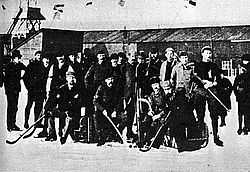
The first recorded games of bandy on ice took place in The Fens during the great frost of 1813–1814, although it is probable that the game had been played there in the previous century. Bury Fen Bandy Club[36] from Bluntisham-cum-Earith, near St Ives, was the most successful team, remaining unbeaten until the winter of 1890–1891. Charles G Tebbutt of the Bury Fen bandy club was responsible for the first published rules of bandy in 1882, and also for introducing the game into the Netherlands and Sweden, as well as elsewhere in England where it became popular with cricket, rowing and hockey clubs. Tebbutt's home-made bandy stick can be seen in the Norris Museum in St Ives.
England won the European Bandy Championships in 1913,[37] but that turned out to be the grand finale, and bandy is now virtually unknown in England. In March 2004, Norwegian ex-player Edgar Malman invited two big clubs to play a rink bandy exhibition game in Streatham, London. Russian Champions and World Cup Winner Vodnik met Swedish Champions Edsbyns IF in a match that ended 10–10. In 2010 England became a Federation of International Bandy member. The federation is based in Cambridgeshire, the historical heartland.[38]
Finland
Bandy was introduced to Finland from Russia in the 1890s. Finland has been playing bandy friendlies against Sweden, Norway and Estonia since its independence in 1917.
The first Finnish national championships were held in 1908 and was the first national Finnish championship held in any team sport. National champions have been named every year except for three years in the first half of the 20th Century when Finland was at war. The top national league is called Bandyliiga and is semi-professional. The best players often go fully professional by being recruited by clubs in Sweden or Russia.
India
India has a national bandy team. Bandy Federation of India takes care of bandy in India. Its headquarters is in Mandi in Himachal Pradesh. Bandy is generally played in northern India where there is generally snow and ice. India is one of 6 countries in Asia and in total 28 to be a member of Federation of International Bandy. BFI planned to send a team to the tournament in Astana-Almaty 2011,[39] but ultimately did not.
Kazakhstan
Bandy has a long history in many parts of the country and it used to be one of the most popular sports in Soviet times. However, after independence it suffered a rapid decline in popularity and only remained in Oral (often called by the Russian name, Uralsk), where the country's only professional club Akzhayik is located. They are competing in the Russian second division. Recently bandy has started to gain popularity again outside of Oral. The former capital Almaty has in recent years hosted both the Asian Winter Games (with bandy on the program) as well as the Bandy World Championship in which Kazakhstan finished 3rd. Plans are made to reinvigorate the bandy section of the club Dynamo Almaty, who won the Soviet Championships in 1977 and 1990 as well as the European Cup in 1978. The Asian Bandy Federation also has its headquarters in Almaty. Since a few years the state is supporting bandy. Medeo is the only arena with artificial ice. A second one in Almaty was built for the World Championship 2012. However, it was taken down afterwards. Stadion Yunost in Oral will get artificial ice for the 2015-16 season.
Norway
Bandy was introduced to Norway in the 1910s. The Swedes contributed largely, and clubs sprang up around the capital of Oslo. Oslo, including neighbouring towns, is still today the region where bandy enjoys most popularity in Norway.
In 1912 the Norwegians played their first National Championship, which was played annually up to 1940. During WWII, illegal bandy was played in hidden places in forests, on ponds and lakes. In 1943, −44 and −45, illegal championships were held. In 1946 legal play resumed and still goes on. After WWII the number of teams rose, as well as attendance which regularly were in the thousands, but mild winters in the 1970s and 80s shrunk the league, and in 2003 only 5 clubs (teams) fought out the 1st division with low attendance numbers and little media coverage.
In recent years, the number of artificially frozen pitches have increased in Norway, and more sports clubs have reinvigorated their bandy sections with new men's and youth teams. Because of this, as well as an increase of Swedish players in Norway, the competitiveness of the game has risen, especially in the first division Eliteserien. The adult men's game in Norway today consists of Eliteserien with 8 teams, as well as 3 lower divisions. Bandy in Norway has also started to spread geographically, and while the sport is more popular than ice hockey in and around the capital Oslo, some clubs in apart locations in the 3rd division only have access to hockey rinks and therefor play rink bandy for home games. Compared to the past, attendance is still fairly low, but important Eliteserien matches can attract around 1000 spectators.
Russia
In Russia bandy is known as hockey with a ball or simply Russian hockey. A similar game became popular among the Russian nobility in the early 1700s, with the imperial court of Peter the Great playing a predecessor of modern bandy on Saint Petersburg's frozen Neva river. Russians played this game using ordinary footwear, with sticks made out of juniper wood, only later were skates introduced. It was only in the second half of the 19th century that bandy became popular among the masses throughout the Russian Empire. Traditionally the Russians used a longer skate blade than other nations, giving them the advantage of skating faster. However, they would find it more difficult to turn quickly. A bandy skate has a longer blade than a hockey skate, and the "Russian skate" even longer.
When the Federation of International Bandy was formed in 1955, with the Soviet Union as one of its founding members, the Russians largely adopted the international rules of the game developed in England in the 19th century, with one notable exception. The other countries adopted the border.
Bandy is considered a national sport in Russia.[40]
The Russian Bandy Super League is played every year and the winner in the final becomes Russian champion.
Sweden
Bandy was introduced to Sweden in 1895. The Swedish royal family, barons and diplomats were the first players. Swedish championships for men have been played annually since 1907. In the 1920s students played the game and it became a largely middle class sport. After Slottsbrons IF won the Swedish championship in 1934 it became popular amongst workers in the smaller industrial towns and villages. Bandy remains the main sport in many of these places.
Bandy in Sweden is famous for its "culture" – both playing bandy and being a spectator requires great fortitude and dedication. A "bandy briefcase" ("bandyportfölj" in Swedish) is the classic accessory for spectating – it is typically made of brown leather, well worn and contain a warm drink in a thermos and/or a bottle of liquor.[41] Bandy is most often played at outdoor arenas during winter time, so the need for spectators to carry flask or thermoses of 'warming' liquid like Glögg is a natural effect.
A notable tradition is "Annandagsbandy", bandy on Boxing Day, which formerly marked the start of the bandy season and always draw bigger crowds than usual. Matches traditionally begin at 1:15 pm.[42]
The final match for the Swedish Championship is played every year on the third Sunday of March. From 1991 to 2012, it was played at Studenternas Idrottsplats in Uppsala, at times drawing crowds in excess of 20,000. The reason for why the play-off match was set in Uppsala is because of IFK Uppsala and its success in the beginning of the 20th century. IFK Uppsala won 11 titles in the Swedish Championships between 1907 and 1920, which made them the most successful Bandyclub in the entire country. Now, however, the record is held by the club Västerås SK
In 2013 and 2014 the final was played indoors in Friends Arena, the new national stadium for football in Solna with retractable roof with a capacity of 50 000. For 2015, Tele2 Arena in Stockholm was chosen instead.
United States
Bandy has been played in the United States since around 1980. The activity is mainly centred to Minnesota even if a fan interest also exist in other states. The bandy clubs in the US only have teams but the interest is stable and even if some clubs folds after only some years, other clubs have been around from the start and have a steady following. The United States national bandy team has taken part in the Bandy World Championships since 1985 and is also regularly playing friendlies against Canada.
United States bandy championships have been played annually since the early 1980s, but the league is still not widely followed by sports media in the country.
National Bandy Federations
- Afghanistan – Bandy Federation of Afghanistan
- Argentina – Argentine Bandy Union
- Armenia – Armenian National Federation of Bandy
- Australia – Australian Bandy League
- Belarus – Беларуская федэрацыя хакея з мячaм (Belarusian Bandy Federation)
- Canada – Canada Bandy[43]
- People's Republic of China – Chinese Ice Hockey Association
- Estonia – Eesti Jääpalliliit[44]
- Finland – Finland's Bandy Association[45]
- Hungary – Hungarian Bandy Federation [46]
- India – Bandy Federation of India
- Ireland – Bandy Federation of Ireland
- Italy – Federazione Italiana Bandy
- Japan – Japan Bandy Federation[47]
- Kazakhstan – Kazakhstan Bandy Federation
- Kyrgyzstan – Bandy Federation of Kyrgyzstan
- Latvia – Latvijas Bendija Federācija[48]
- Lithuania – Lithuanian Bandy Association
- Mongolia – Bandy Federation of Mongolia
- Netherlands – Nederlandse Roller Sport and Bandy Bond[49]
- Norway – Norges Bandyforbund[50]
- Poland – Bandy Federation of Poland
- Russia – Всероссийская федерация хоккея с мячом (All Russian Bandy Federation)[51]
- Serbia – Bandy Federation of Serbia
- Somalia – Somali National Bandy Association[52]
- Sweden – Svenska Bandyförbundet[53]
- Switzerland – Federation of Swiss Bandy
- Ukraine – Українськa Федерація хокею з м'ячем та рінк-бенді (Ukrainian Bandy and Rinkbandy Federation)[54]
- United States – American Bandy Association[55]
References
- ↑ Arlott, John, ed. (1975). "Bandy". The Oxford Companion to Sports & Games. Oxford: Oxford University Press.
- ↑ "Edsbyn Sandviken SM – Final in Upssala". YouTube. Retrieved 7 February 2014.
- ↑ "bandy". Webster's Sports Dictionary. Springfield, Mass.: G&G Merriam Company. 1976. p. 28.
- ↑ 4.0 4.1 "Bandy Playing Rules" (PDF). Federation of International Bandy. 1 September 2011. Retrieved 25 March 2014.
- ↑ "Bandy Glossary". Fuzilogik.com. Retrieved 3 March 2012.
- ↑ "Federation of International Bandy" (PDF). Retrieved 7 February 2014.
- ↑ emh solutions. "Olympic". Worldbandy.com. Retrieved 7 February 2014.
- ↑ Eurosport (12 February 2010). "Bandyn tror på plats i nästa vinter-OS" (in Swedish). Eurosport.se. Retrieved 25 March 2014.
- ↑
- ↑ "Asian Winter Games Sports 2017, Asian Winter Games 2017 Events, Competition Programme, Disciplines". Altiusdirectory.com. Retrieved 25 March 2014.
- ↑ Official site of 2017 Asian Winter Games
- ↑ Fransson, Martin (26 October 2008). "Isen smälte – då vann Edsbyn hemma". Dagens Nyheter (in Swedish). Archived from the original on 27 January 2009. Retrieved 13 January 2009.
- ↑ "Bandysidan". Bandysidan.nu. Retrieved 9 April 2014.
- ↑ emh solutions (10 January 2012). "Federation of International Bandy | Federation of International Bandy". Worldbandy.com. Retrieved 7 February 2014.
- ↑ "2017 Almaty Winter Universiade: Dates confirmed". Fisu.net. 10 February 2014. Retrieved 9 April 2014.
- ↑ "The Universiade in Almaty could serve as an Impetus to the Development of Bandy". Fisu.net. Retrieved 7 February 2014.
- ↑ "WORLD WINTER UNIVERSIADE ALMATY 2017 Spread your wings!". 2017almaty.com. 10 December 1997. Retrieved 7 February 2014.
- ↑ Решения Исполкома ФХМР от 3 декабря. rusbandy.ru. 9 December 2013
- ↑ Крытый ледовый дворец в Красноярске примет 7 тысяч зрителей. rusbandy.ru. 10 December 2013
- ↑
- ↑ "Switzerland". Web.archive.org. 28 October 2009. Archived from the original on 28 October 2009. Retrieved 3 March 2012.
- ↑ "Official rules, bandy and rink bandy". Internationalbandy.com. 23 September 2009. Retrieved 3 March 2012.
- ↑ "Rinkbandy – Visit Sodra Dalarna". Visitsodradalarna.se. 24 May 2011. Retrieved 7 February 2014.
- ↑ 24.0 24.1 24.2 24.3 24.4 "Svenska Bandyförbundet, bandyhistoria 1875–1919". Iof1.idrottonline.se. 1 February 2013. Retrieved 9 April 2014.
- ↑ "Photo of Bury Fen Bandy Club". Web.archive.org. 28 October 2009. Archived from the original on 28 October 2009. Retrieved 3 March 2012.
- ↑ "The Finnish Bandy Federation, in English". Finnish Bandy Association. Retrieved 20 April 2014.
- ↑ Federation of International Bandy (October 2003). "National Federations". Retrieved 4 June 2010.
- ↑ "Hockey in Montreal since the 19th Century | Thematic Tours | Musée McCord Museum". Mccord-museum.qc.ca. Retrieved 7 February 2014.
- ↑ Nordisk Familjebok 10 Hassle-Infektera, Förlagshuset Norden AB, Malmö 1952, "Hockey", column 386
- ↑ Nordisk Familjebok 2 Asura-Bidz, Förlagshuset Norden AB, Malmö 1951, "Bandy", columns 324–326
- ↑ 31.0 31.1 Eric Converse (17 May 2013). "Bandy: The Other Ice Hockey". The Hockey Writers. Retrieved 6 May 2014.
- ↑ E.g. in the Netherlands, see Arnout Janmaat (7 March 2013). "120 jaar bandygeschiedenis in Nederland (1891–2011)" (PDF). p. 10. Retrieved 13 February 2014.
- ↑ Waldemar Ingdahl (12 November 2008). "Bandy – ice hockey in Sweden goes big in Europe". Café Babel. Retrieved 6 May 2014.
- ↑ Joe Posnanski (14 February 2014). "Russians no longer mesmerize with brilliant hockey but golden feeling is there". NBC Sports Pro Hockey Talk. Retrieved 21 February 2014.
- ↑ "Online Etymology Dictionary, "bandy"". Online Etymology Dictionary. 2011. Retrieved 4 January 2012.
- ↑ Photo of Bury Fen Bandy Club at the Wayback Machine (archived October 28, 2009)
- ↑ "England in European Bandy Championships". Web.archive.org. 28 October 2009. Archived from the original on 28 October 2009. Retrieved 3 March 2012.
- ↑ "England profile at Federation of International Bandy". Internationalbandy.com. Retrieved 3 March 2012.
- ↑ "На турнире Азиады 2011 выступят 5 сборных". Bandynet.Ru. Retrieved 7 February 2014.
- ↑ "Russian bandy players blessed for victory at world championship in Kazan". Tatar-Inform. 21 January 2011. Retrieved 31 August 2009.
- ↑ Sundberg, Ingrid (10 November 2006). "Bandyportföljens tid är här". Folket (in Swedish). Archived from the original on 28 September 2007. Retrieved 7 January 2007.
- ↑ Rosqvist, Berndt (22 December 2003). "Festligt och fullsatt på stora bandydagen". Dagens Nyheter (in Swedish). Retrieved 4 February 2010.
- ↑ "Welcome to Canada Bandy". Canadabandy.ca. Retrieved 20 September 2010.
- ↑ "Pealeht". Hot.ee. Retrieved 20 September 2010.
- ↑ "Suomen jääpalloliitto". Finbandy.fi. Archived from the original on 3 October 2010. Retrieved 20 September 2010.
- ↑ "Hungarian Bandy Federation". Bandy.hu. Retrieved 20 September 2010.
- ↑ "日本バンディ連盟:トップページ". J-bandy.jp. 15 November 2011. Retrieved 9 December 2011.
- ↑ Aigars Krjanins. "Latvijas Bendija Federācija". Bandy.lv. Retrieved 20 September 2010.
- ↑ "nrbb.nl". Ndparking.com. Retrieved 25 March 2014.
- ↑ "Norges Bandyforbund – Bandy". Bandyforbundet.no. Retrieved 20 September 2010.
- ↑ "Федерация хоккея с мячом России". Rusbandy.ru. Retrieved 20 September 2010.
- ↑ SomaliaBandy2014 (24 August 2013). "Somalia Bandy 2014". Somalia Bandy 2014. Retrieved 7 February 2014.
- ↑ "Svenska Bandyförbundet". svenskbandy.se. Archived from the original on 12 August 2010. Retrieved 20 September 2010.
- ↑ "Українська Федерація хокею з м'ячем і рінк-бенді". Ukrbandy.org.ua. Retrieved 20 September 2010.
- ↑ "American Bandy Association". Usabandy.com. Retrieved 20 September 2010.
Bibliography
- The Earl of Suffolk and Berkshire Hedley Park and Aflalo, F.G. Bandy (includes definition and rules), pp. 71 – 72, 1897. published by Lawrence & Bullen, Ltd., 16 Henrietta St., Covent Garden, London.
External links
| Wikimedia Commons has media related to Bandy. |
- What is Bandy? at the Wayback Machine (archived October 27, 2009) – History and rules of Bandy.
- Bandy at DMOZ
- Federation of International Bandy
- Bandysidan links – One of the most extensive link directories about bandy
- Klein, Jeff Z. "It's Not Hockey, It's Bandy," The New York Times, Friday, 29 January 2010.
- Goalwire statistics for bandy
| ||||||||||||||||||||||||||||||||||||||||||||||||||||||||||||||
